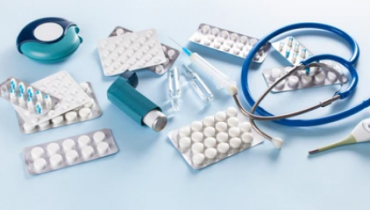Pharmacist action
Стилизация Salbutamol has a highly selective stimulating effect on beta2-adrenergic receptors, activates adenylate cyclase located in cells. The bronchodilator effect of salbutamol is due to the relaxation of the smooth muscles of the bronchi. Salbutamol acts for a long time, since it is not destroyed in the lungs by catechol-O-methyltransferase. Salbutamol slows down the contractile activity of the myometrium, relaxes the uterus, and prevents premature birth. When inhaled, 10–20% of salbutamol reaches the small bronchi, where it is gradually absorbed into the systemic circulation, part of the dose is absorbed in the gastrointestinal tract when swallowed. Salbutamol is well absorbed when using long-acting tablets. The maximum concentration is 30 ng / ml. The duration of the circulation of salbutamol in the blood (at a therapeutic concentration) is 3-9 hours, after which the content of the drug gradually decreases. Salbutamol binds to plasma proteins by 10%параграфа

Vydelyayetsya s grudnym molokom i prokhodit cherez platsentu. V pecheni sal’butamol podvergayetsya biotransformatsii. Period poluvyvedeniya sostavlyayet 3,8 chasa. Nezavisimo ot sposoba vvedeniya vyvoditsya s zhelch’yu i mochoy, v osnovnom v neizmenennom vide (primerno 90%) ili v forme glyukuronida. Snyatiye bronkhospazma bystreye dostigayetsya pri ingalyatsionnom vvedenii sal’butamola. Rasshireniye bronkhov uzhe nastupayet na 4–5-y minute, vozrastayet k 20-y minute, stanovitsya maksimal’nym cherez 40–60 minut; dlitel’nost’ effekta sostavlyayet 4–5 chasov. Naiboleye vyrazhennyy rezul’tat dostigayetsya pri ingalyatsii 2 doz sal’butamola, dal’neysheye uvelicheniye dozy k rostu bronkhial’noy prokhodimosti ne privodit, no povyshayetsya vozmozhnost’ razvitiya pobochnykh reaktsiy (golovnaya bol’, tremor, golovokruzheniye). Sal’butamol polozhitel’no vozdeystvuyet na mukotsiliarnyy klirens (povyshayet yego na 36% pri khronicheskom bronkhite), aktiviruyet funktsii mertsatel’nogo epiteliya, stimuliruyet sekretsiyu slizi. Zamedlyayet vydeleniye iz bazofilov i tuchnykh kletok mediatorov vospaleniya (naprimer, anti-IgE-indutsirovannyy vybros gistamina), ustranyayet antigenzavisimoye vydeleniye faktora khemotaksisa neytrofilov i podavleniye mukotsiliarnogo transporta. Sal’butamol preduprezhdayet poyavleniye bronkhospazma, vyzvannogo allergenom. Mozhet vyzyvat’ reduktsiyu chisla i desensitizatsiyu beta-adrenoretseptorov, v tom chisle i na limfotsitakh. Sal’butamol imeyet ryad metabolicheskikh effektov — umen’shayet kontsentratsiyu kaliya v plazme, deystvuyet na vydeleniye insulina i glikogenoliz, okazyvayet lipoliticheskiy i giperglikemicheskiy (v osobennosti u bol’nykh bronkhial’noy astmoy) effekt, povyshayet veroyatnost’ razvitiya atsidoza.Ещёvolume_up1630 / 5000
It is excreted in breast milk and passes through the placenta. In the liver, salbutamol undergoes biotransformation. The half-life is 3.8 hours. Regardless of the route of administration, it is excreted in the bile and urine, mainly unchanged (approximately 90%) or in the form of glucuronide.
Removal of bronchospasm is faster achieved with inhaled salbutamol. Expansion of the bronchi already occurs in the 4-5th minute, increases by the 20th minute, becomes maximum in 40-60 minutes; the duration of the effect is 4–5 hours. The most pronounced result is achieved with the inhalation of 2 doses of salbutamol, a further increase in the dose does not lead to an increase in bronchial patency, but the possibility of adverse reactions (headache, tremor, dizziness) increases.
Salbutamol has a positive effect on mucociliary clearance (increases it by 36% in chronic bronchitis), activates the functions of the ciliated epithelium, and stimulates mucus secretion. It slows down the release of inflammatory mediators from basophils and mast cells (for example, anti-IgE-induced release of histamine), eliminates the antigen-dependent release of neutrophil chemotaxis factor and suppression of mucociliary transport. Salbutamol prevents bronchospasm caused by an allergen. It can cause a reduction in the number and desensitization of beta-adrenergic receptors, including on lymphocytes. Salbutamol has a number of metabolic effects – it reduces the concentration of potassium in the plasma, acts on the release of insulin and glycogenolysis, has a lipolytic and hyperglycemic (especially in patients with bronchial asthma) effect, increases the likelihood of acidosis.
Indications
Relief and prevention of bronchial asthma, bronchospasm; nocturnal asthma (prolonged-release tablets); symptomatic therapy of broncho-obstructive syndrome (including chronic bronchitis, emphysema, chronic obstructive pulmonary disease); the threat of premature birth (with gestational age from 16 to 38 weeks).
Salbutamol acts as an active substance in the drug Ventolin in the form of tablets or aerosols.
Contraindications
Hypersensitivity, breastfeeding, pregnancy (for use as a bronchodilator), childhood (up to 4 years – for powder for inhalation, up to 2 years – for metered aerosol without a spacer and for oral administration, up to 18 months – for solution for inhalation); additionally for intravenous administration as a tocolytic: intrauterine fetal death, infection of the birth canal, fetal malformations, bleeding with premature placental abruption or placenta previa; threatening miscarriage (in the 1st and 2nd trimester of pregnancy).
Dosage
Salbutamol is administered by inhalation, intravenous injection, or by mouth (regardless of food intake). Inhalation: relief of an incipient asthma attack – 100-200 mcg (1-2 breaths); after 5 minutes, repeated inhalation is possible if there is no effect; further inhalations are performed at intervals of 4–6 hours (no more than 6 inhalations per day); regular use – 2-4 times / day, 1-2 inhalations; prevention of bronchospasm – use 15–20 minutes before contact with frosty air. Powder for inhalation: a single dose is equal to 200-400 mg (doses are twice as high due to lower bioavailability). During a severe attack, it is possible to administer an inhalation solution using various designs of nebulizers for 5-15 minutes; the initial dose for patients older than 18 months is 2.5 mg (if necessary, 5 mg is possible) up to 4 times a day. Inside, for patients over 12 years old, 3-4 times a day, 2-4 mg, the maximum single dose is 8 mg, the daily dose is 32 mg; children 6-12 years old – 3-4 times a day, 2 mg, the maximum dose is 24 mg / day, children 2-6 years old – 3-4 times a day, 1-2 mg (0.1 mg / kg). Prolonged-release tablets: a patient over 12 years old – every 12 hours at 4-8 mg, the maximum dose is 32 mg / day (every 12 hours 16 mg), children 6-12 years old – every 12 hours 4 mg, the maximum dose is 24 mg / day (every 12 hours, 12 mg). As a tocolytic agent: intravenously drip – 2.5–5 mg diluted in 500 ml of 5% dextrose solution or 0.9% sodium chloride solution, the rate of salbutamol administration depends on the tolerance of the drug and the intensity of uterine contractile activity. Further, there is a maintenance oral treatment with salbutamol in the form of tablets: 4–5 times a day, 2–4 mg; the first tablet is taken 15-30 minutes before the end of the infusion; the duration of treatment is 14 days.
When using a metered aerosol, the following instructions must be observed: before each use, shake the aerosol can, clearly synchronize the drug intake and inhalation, make the deepest, sufficiently long and intense inhalation as possible, after inhaling the drug, hold your breath for 10 seconds. For patients who find it difficult to perform the correct breathing maneuver, it is recommended to use spacers (special devices) for inhalation of the drug, which smooth out the inaccuracies of asynchronous inspiration and increase the tidal volume. To increase the effectiveness of treatment, the patient must be taught the correct use of the inhaler; at the beginning of therapy, use the inhaler under the supervision of medical personnel. The use of salbutamol in exacerbation of asthma in high doses leads to an increase in the intensity of the subsequent asthma attack (rebound syndrome). In case of a severe attack of suffocation, the interval between inhalations of salbutamol should be at least 20 minutes. In the absence of minimal effects from inhalation or the development of tachycardia, severe tremor, arrhythmias, further uncontrolled use of the inhaler is contraindicated, you need to consult a doctor. The risk of complications increases with a significant duration of therapy, as well as abrupt withdrawal of the drug.

Side effects
- nervous system: anxiety, tremors (usually of the hands), tension, dizziness, hyperexcitability, sleep disturbances, headache, short-term convulsions;
- circulatory system: tachycardia (including in the fetus during pregnancy), palpitations, arrhythmias, increased or decreased blood pressure, expansion of peripheral vessels, heart failure, myocardial ischemia, cardiopathy;
- digestive system: nausea, irritation or dryness in the mouth or throat, vomiting, loss of appetite;
- others: pharyngitis, bronchospasm (caused by hypersensitivity to salbutamol or paradoxical), sweating, difficulty urinating, increased blood glucose levels, free fatty acids, dose-dependent hypokalemia, the development of mental and physical drug dependence, allergic reactions in the form of facial edema, erythema, shortness of breath
Interaction
Salbutamol increases the cardiotropy of thyroid hormones, the activity of stimulants of the central nervous system. Ephedrine and theophylline enhance the toxic effects of salbutamol. Inhibitors of prostaglandin synthesis, corticosteroids, MAO blockers and tricyclic antidepressants increase the likelihood of complications from the circulatory system, levodopa and inhalation anesthesia – severe ventricular arrhythmias. Salbutamol reduces the effectiveness of antihypertensive drugs, beta-blockers (including ophthalmic forms), the antianginal effect of nitrates. Salbutamol increases the risk of glycoside intoxication when used together.
Special instructions
Restrictions on use
Tachyarrhythmia, ischemic heart disease, severe arterial hypertension, heart disease, myocarditis, severe heart failure, aortic stenosis, thyrotoxicosis, diabetes mellitus, pheochromocytoma, severe renal and / or liver failure.
Application during pregnancy and lactation
The use of salbutamol is contraindicated during pregnancy and lactation.
Overdose
With an overdose of salbutamol, a decrease in blood pressure, tachycardia (pulse rate up to 200 beats per minute), ventricular flutter, increased cardiac output, acidosis, hypoxemia, hyperglycemia, hypokalemia, headache, muscle tremor, agitation, convulsions, hallucinations develop. Necessary: the abolition of salbutamol and symptomatic treatment; the use of selective beta-blockers in patients with bronchial asthma due to the risk of developing a severe bronchospastic reaction requires extreme caution.












I have received my package. thank you. Will use my discount for further orders! Thanks.
I have received my package and it is in fine condition. Thanks.
Hi i have received my package. Thank you!